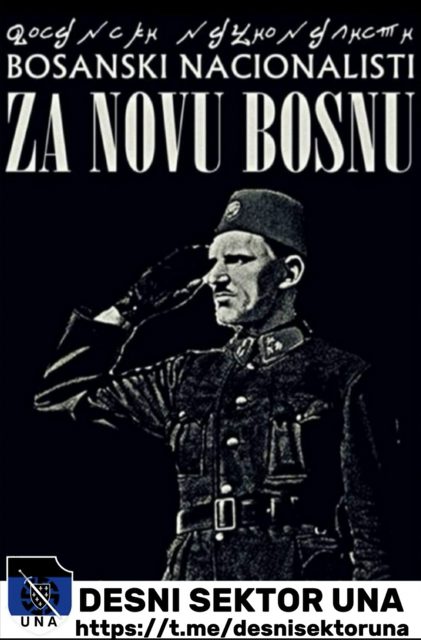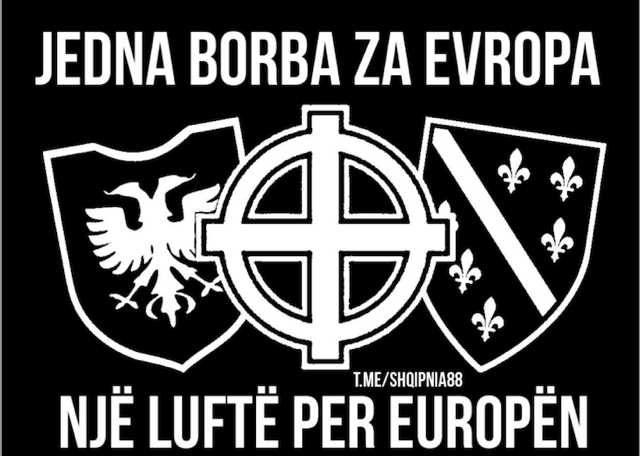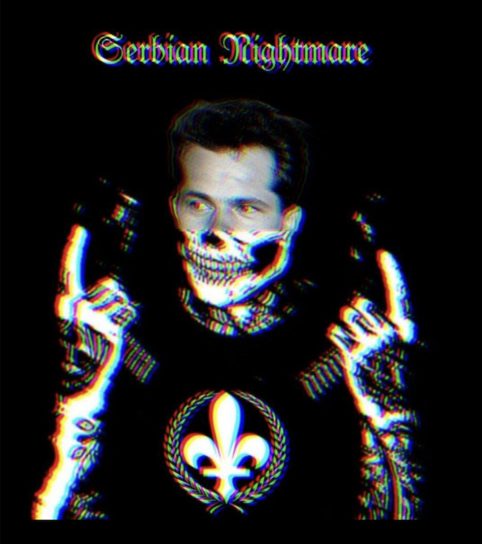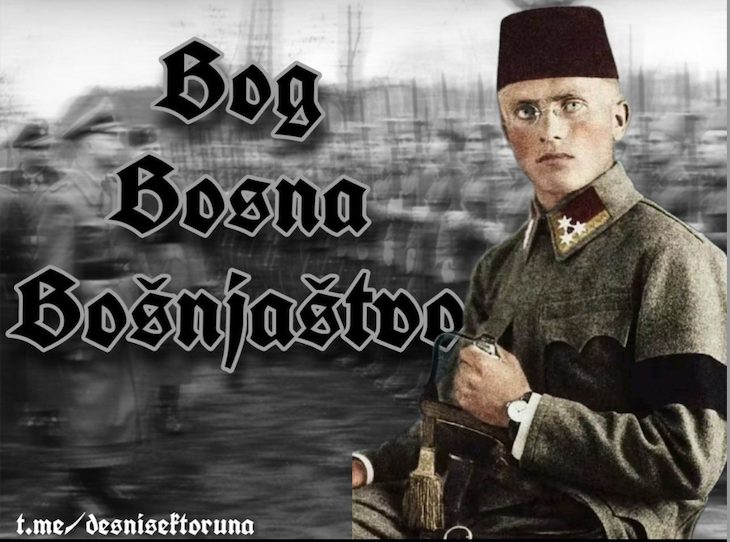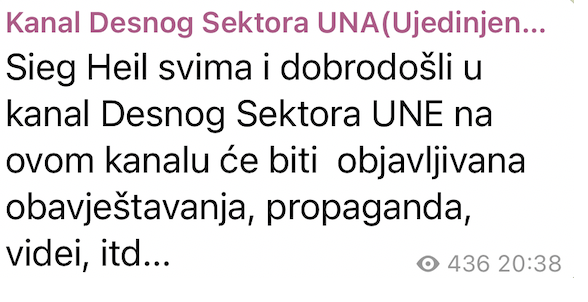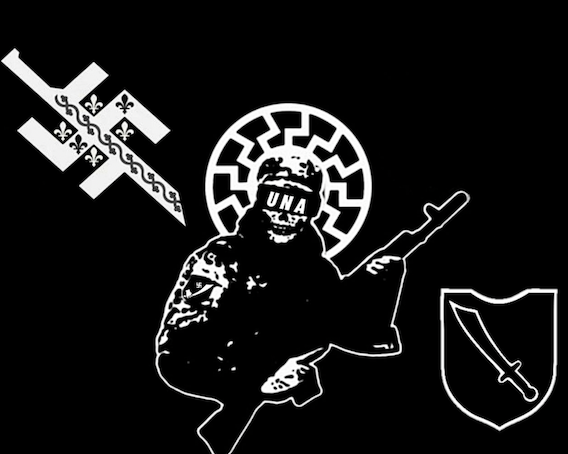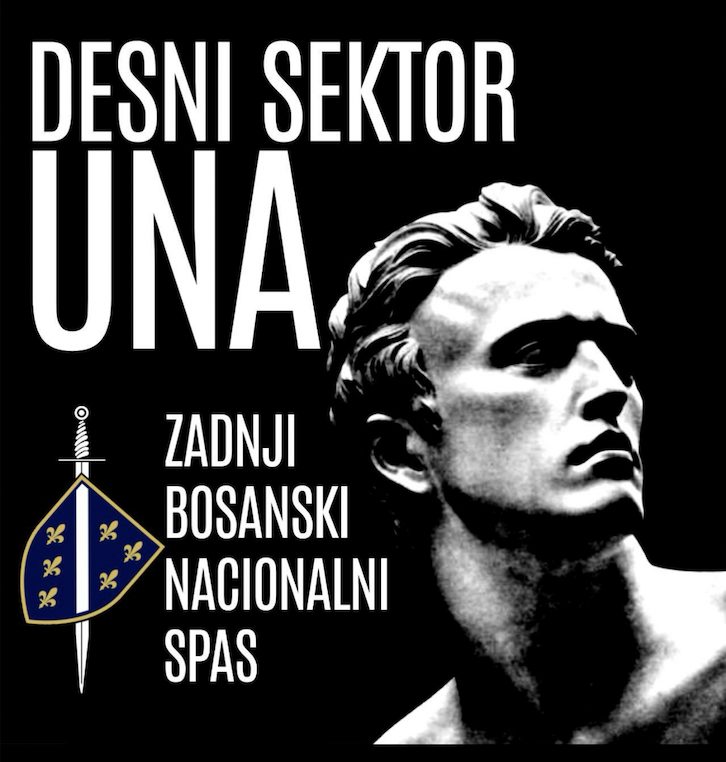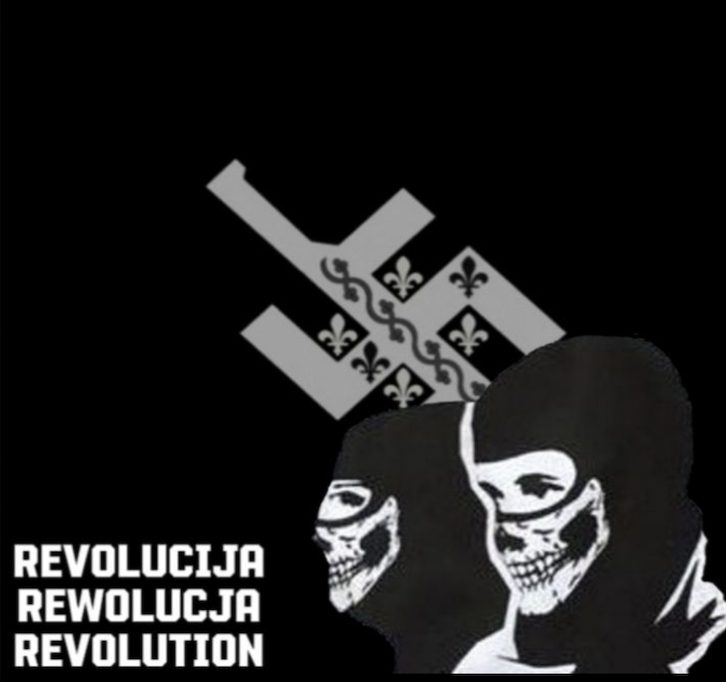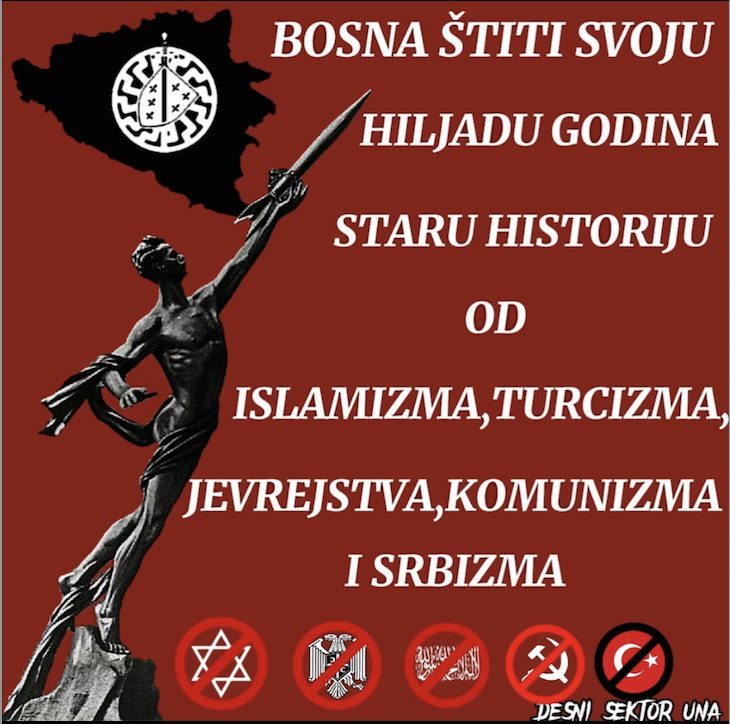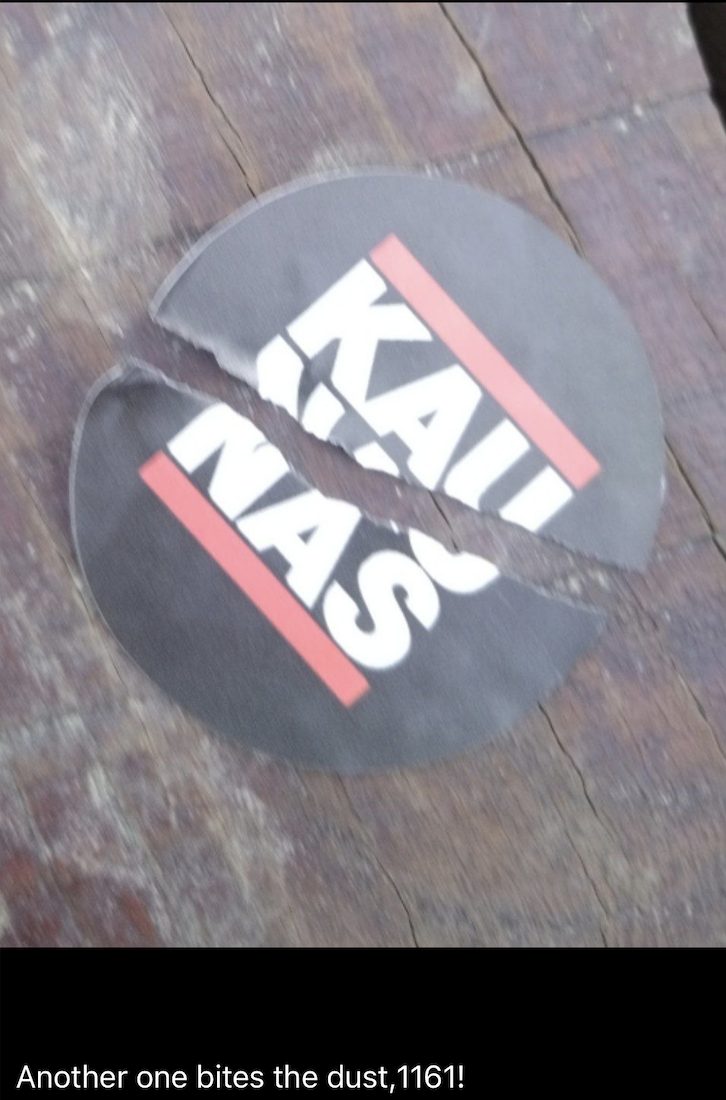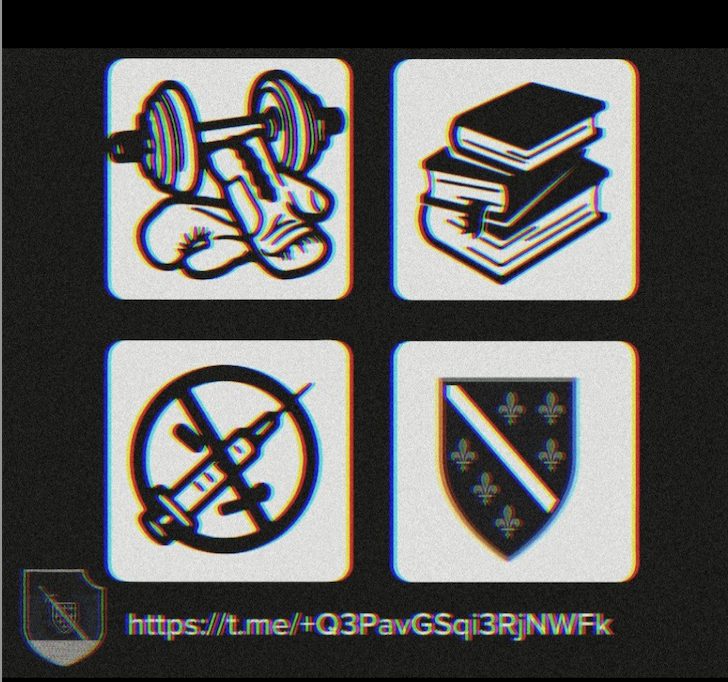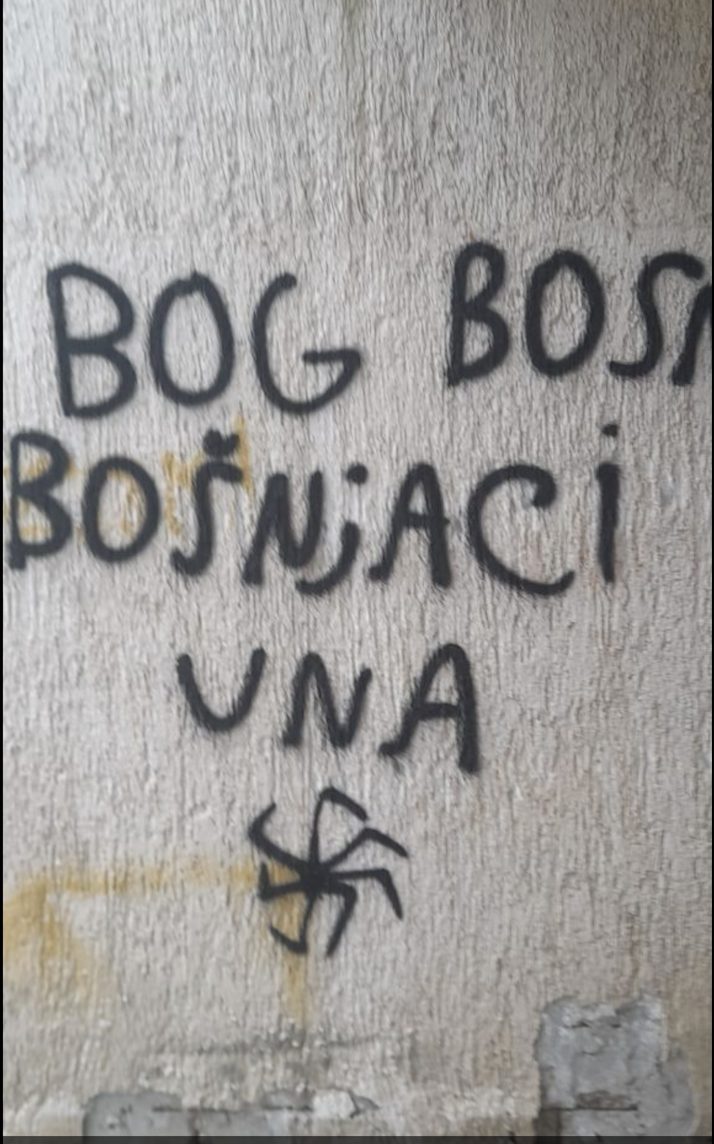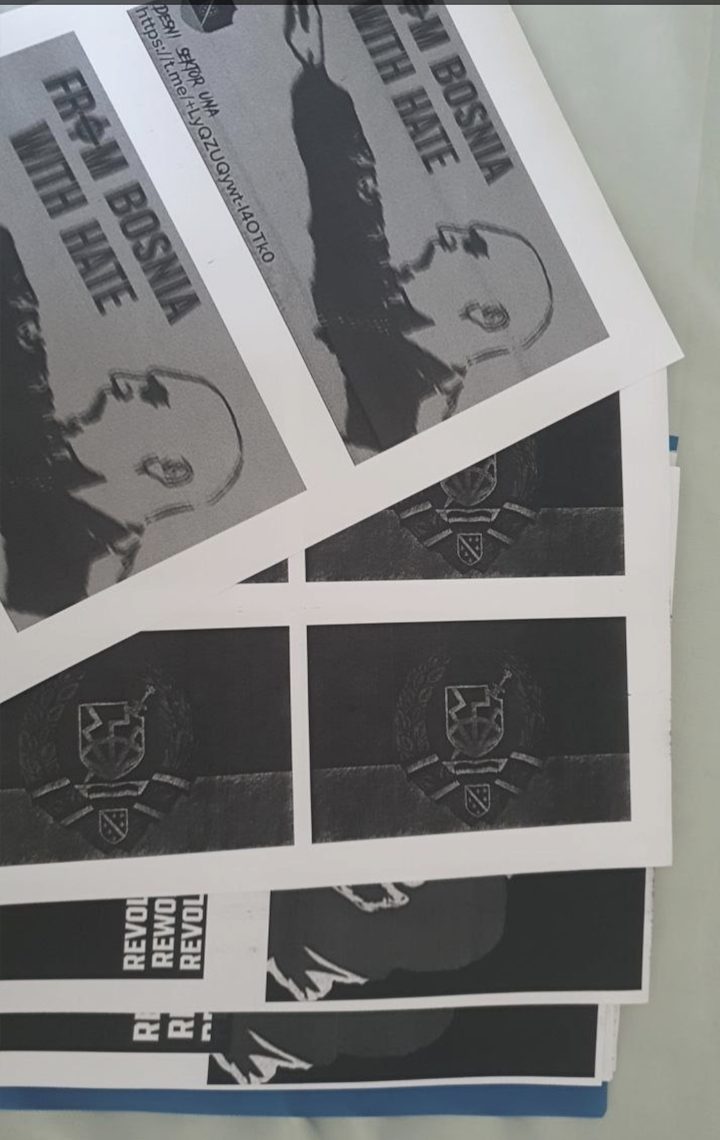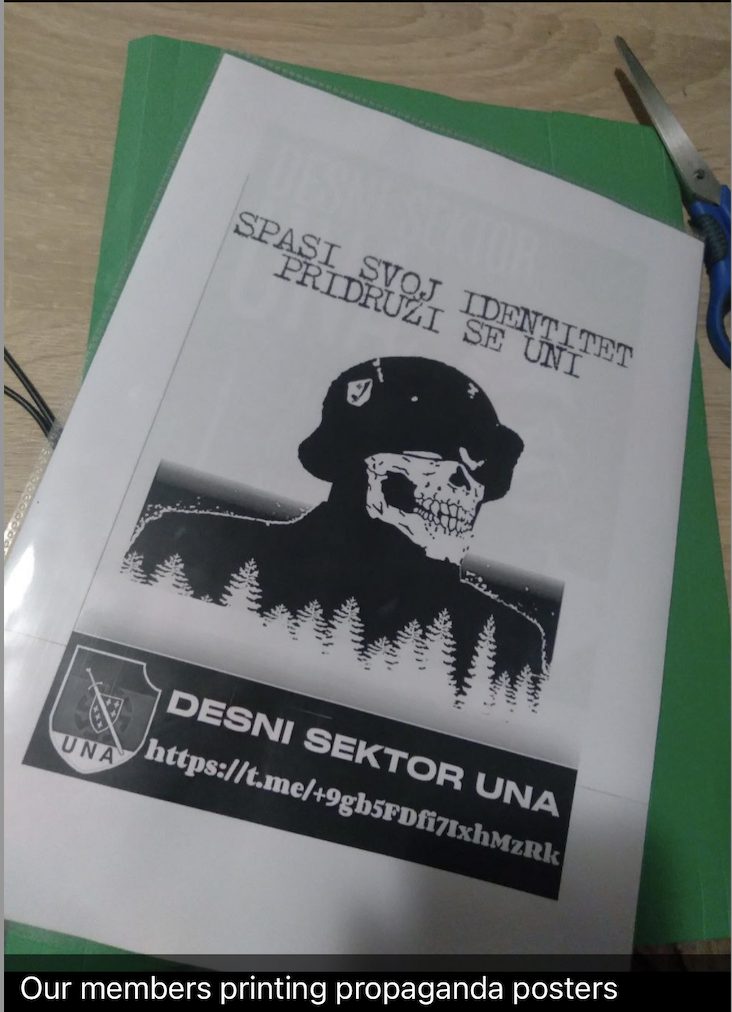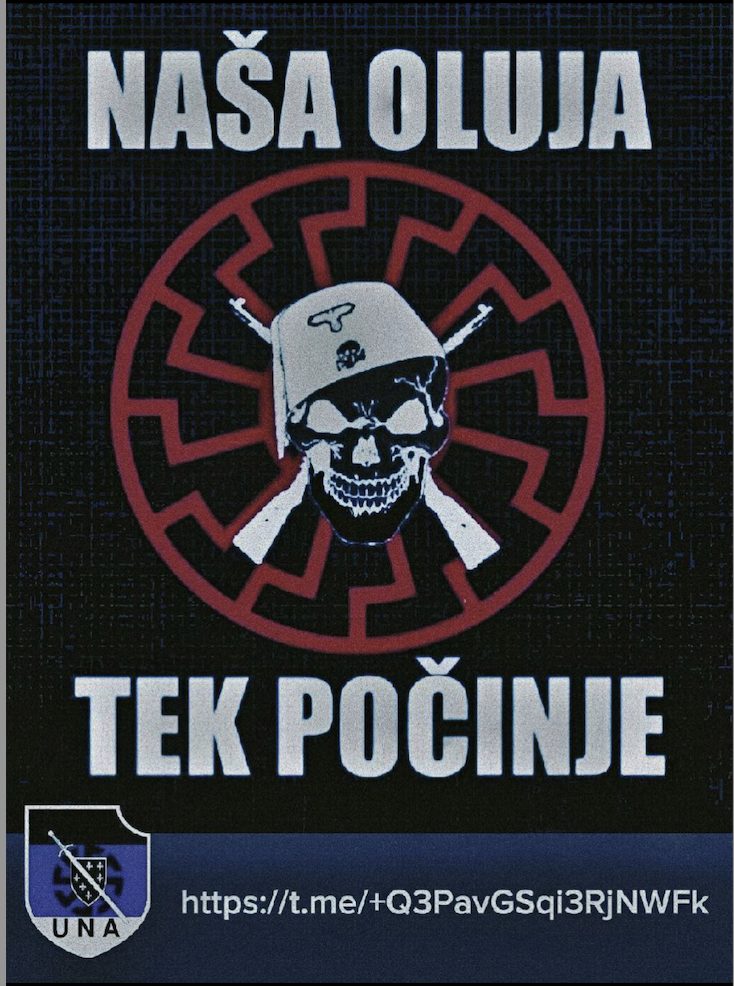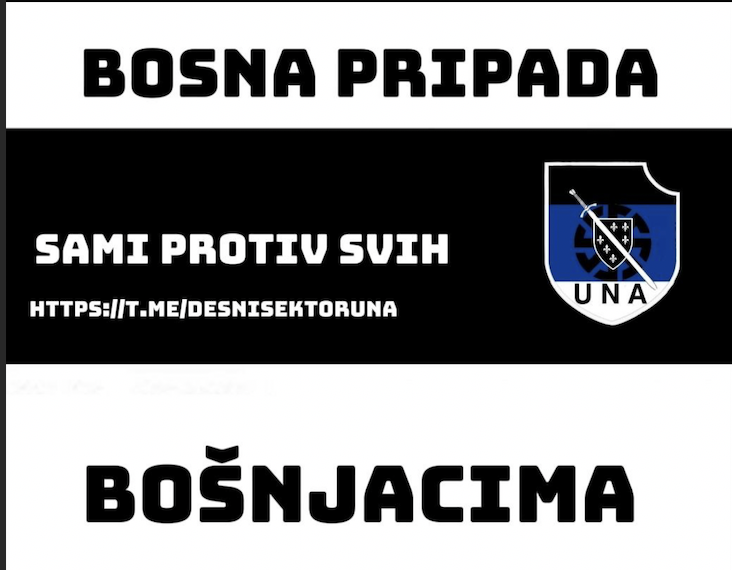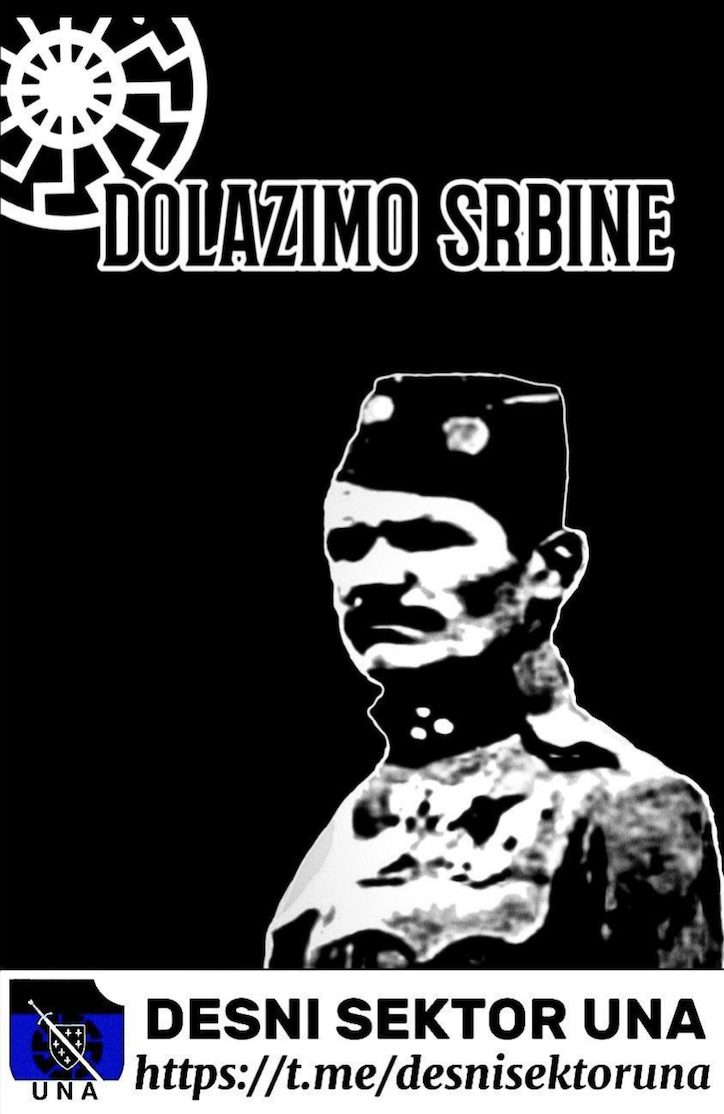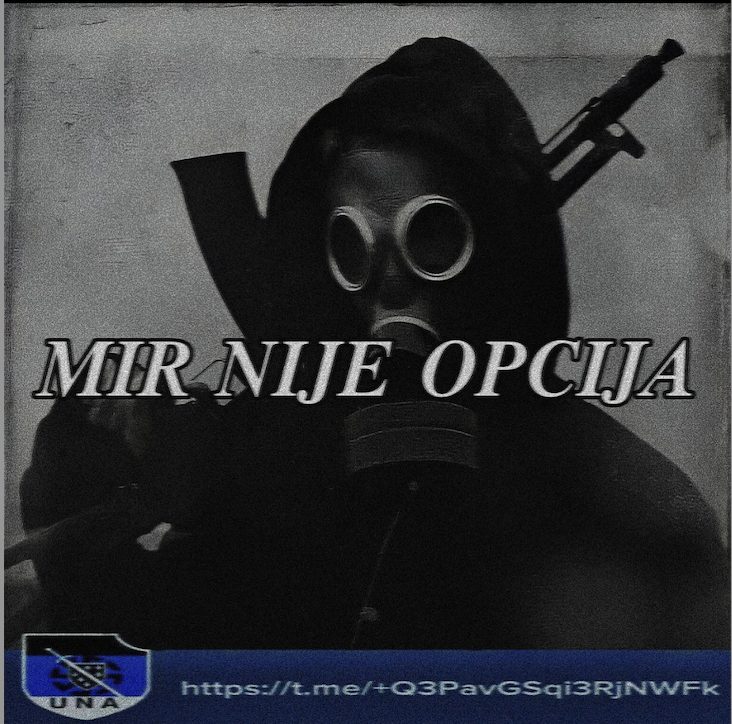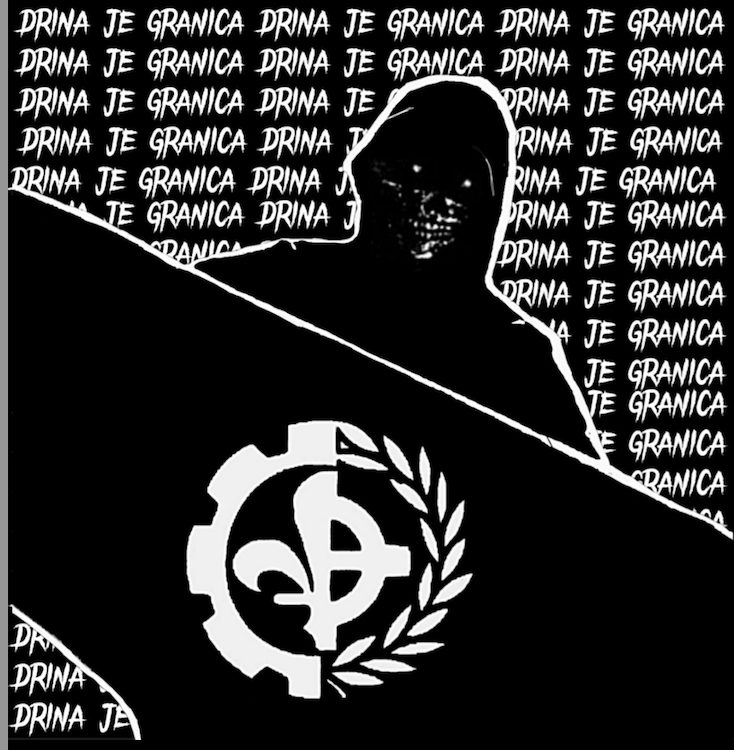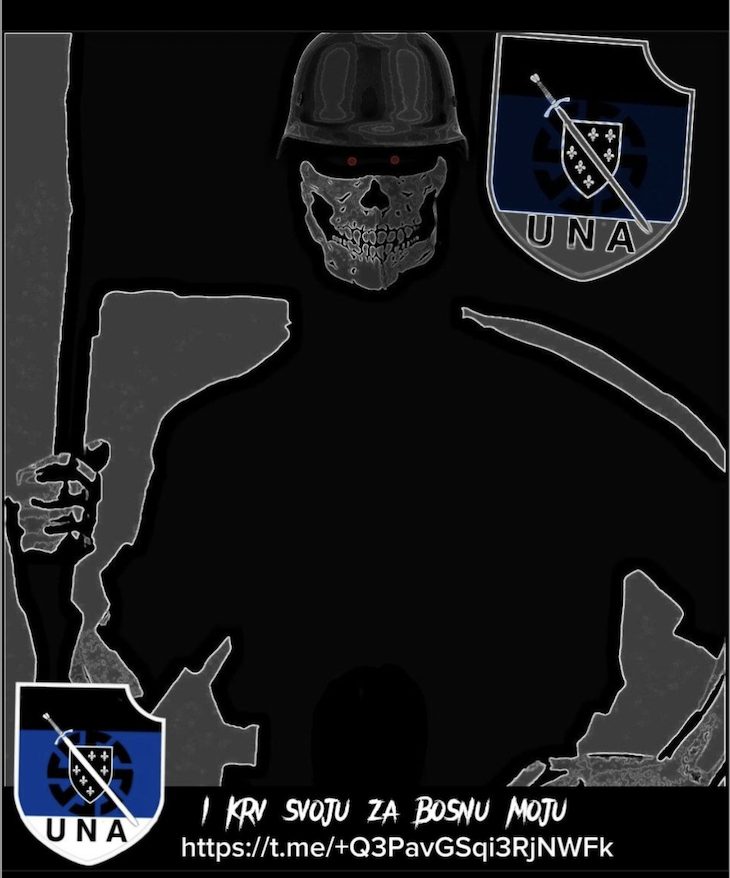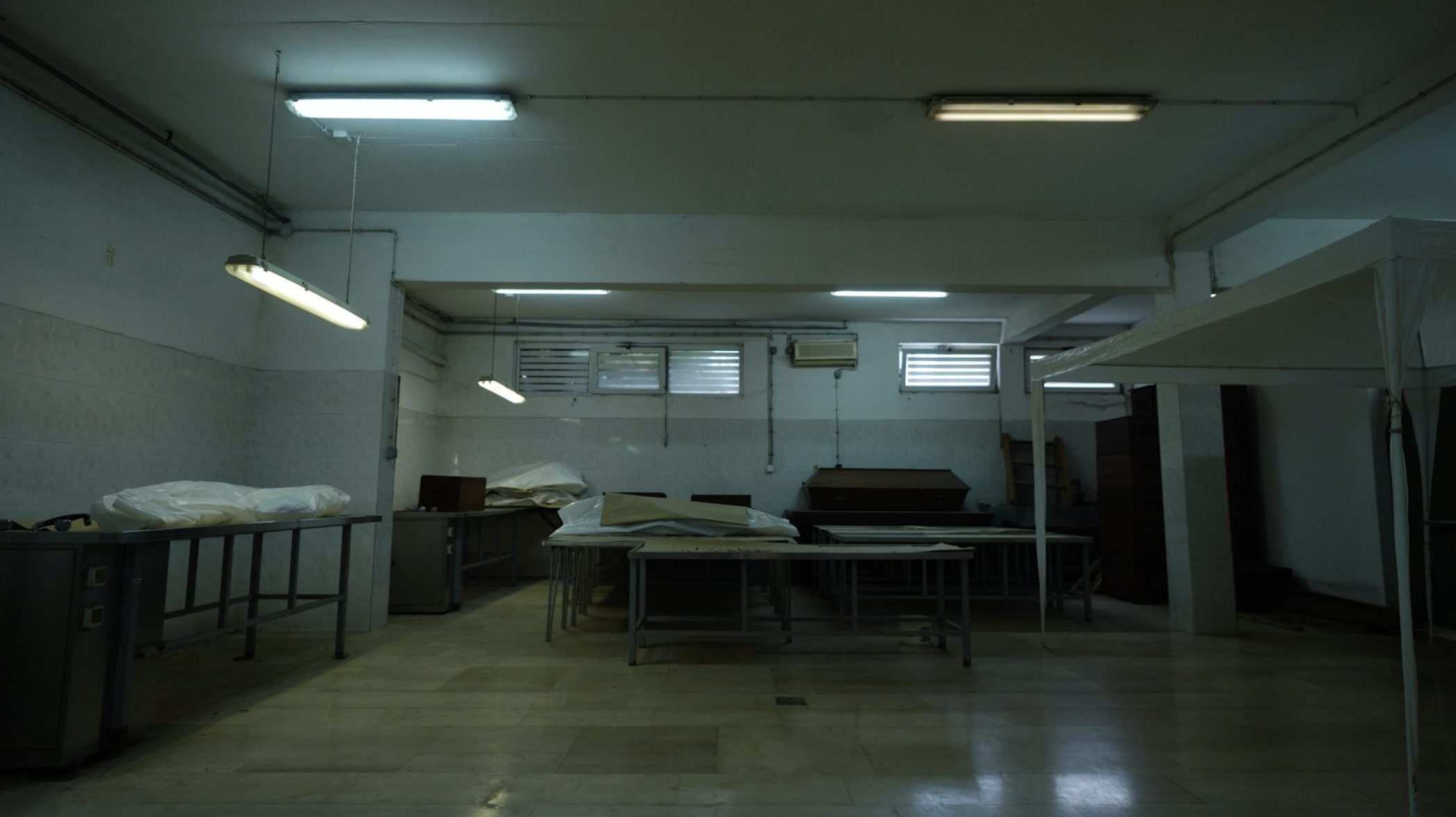This post is also available in: Bosnian
 Source: Telegram group Desni sektor Una
Source: Telegram group Desni sektor Una
Their future goals are to bring in more people to make the movement more substantial and organised, to expand and gain influence. Communications within the group show the typical characteristics of far-right extremist groups, including a focus on identity, perceived historical wrongs, inward-looking nationalism, glorification of the Nazi legacy and attempts to tie that legacy to Bosniak identity, symbols and narratives. It is Bosniak neo-Nazism in the making.
In recent years, several right-wing groups have emerged in Bosnia and Herzegovina. The Balkan Investigative Reporting Network has reported on Bosniak, Croat and Serb extremists; on foreign influence from neo-Nazis, Turkish extremists and Russian extremists; on misogyny and anti-feminism, disinformation, charity work, sports fan groups and the celebration of the unconstitutional Day of Republika Srpska; as well as calls to fight in Ukraine, including Croatian volunteers on the Ukrainian side in the ranks of the Azov Brigade. As stated by NBC investigative journalist April Glaser, right-wing movements and individuals have been using Telegram channels lately to communicate and share ideas with followers. This social media platform enables a carefree approach to spreading hate and mobilising activists, especially when groups are closed to the public. This article deals with publicly available propaganda, symbols and messages that were propagated by Right Sector Una, a newly established Telegram group which was recently closed to the public.
Right Sector Una has been using the platform to spread propaganda and share news clips and historical reports supporting their ideology. A consistent theme is a cycle of mutual affirmation through which members support and strengthen each other’s beliefs.
Members communicate frequently, discussing participation in the group and sharing ideological statements and memes. Based on conversations in the Telegram group, the influence of Right Sector Una allegedly extends from Bosanska Krajina to Zenica, while potential leadership ties extend to Koroska Bela in Slovenia, as is claimed in a propaganda leaflet. The group’s range does not stop at Bosnia and Herzegovina’s borders; it reaches to the diaspora, connecting like-minded extremists in a network of neo-Nazi ideologues who use Bosniak symbols like lilies and the medieval iconography of King Tvrtko. This includes symbols associated with Bosniak nationalism such as modified versions of the symbol of the Bosnian Kingdom and images of an imaginary right-wing ideal of Greater Bosnia.
Symbols, hate speech and calls to action
Group members discuss the use of Bosnian cultural symbols and historical figures to reinforce their claims and attract followers, even when those figures do not represent neo-Nazi ideologies.
Una Right Sector openly expresses anti-Semitic and Islamophobic sentiments. Symbols and figures from the Bosnian Kingdom are presented as part of a narrative that rejects foreign influences and emphasises local heritage. This is used to reject the perception of Islamic influence during the Ottoman period. Members discuss topics such as the alleged threats posed by globalism and Zionism, reflecting conspiracy theories that can be found in extremist circles worldwide. This includes a disturbing claim that the Islamic State was a tool controlled by Jewish interests, an unfounded and harmful narrative used to ignite discord. Discussions in the Telegram group inevitably show elements of conspiratorial thinking, particularly in relation to the influence of Jews, a common trait of far-right rhetoric across the world.
There is a pervasive background of intolerance in the Telegram group and several messages contain derogatory statements about various ethnic and religious groups. It seems that the use of historical figures and nationalistic symbols in their posts is a way to incite Serb nationalism in Bosnia and Herzegovina and create a cycle of radicalisation. Group members express disdain for multiculturalism and globalism, reflecting a neo-Nazi ideology which they perceive as a way to protect their identity and interests from people different from them.
Right Sector Una does not hide its hatred. They openly express disdain for anti-fascists, communists, Serbs and Jews and their discussions are loaded with nationalist insults, xenophobia and racism. This includes derogatory remarks about Armenians. The group’s propaganda is full of symbols and messages glorifying traditional views of family, patriarchy and manliness, and it aims to attract younger audiences. Their use of the Black Sun (a symbol popular among neo-Nazis) alongside Bosnian national symbols and references to respected figures like Izet Nanic – a famous military commander from the 1990s war in Bosnia who was known for his courage but not for extremist ideologies – illustrates their manipulative tactics.
The Telegram group demonstrates a hostile stance towards outsiders or those who reject their views. This is clear from the frustrated answers they give to questions individuals on the channel have posed. A clear mentality of “us against them” pervades discussion.
At times there is an evident attempt to legitimise their stance by distancing themselves from some forms of open extremism, such as through claims that they are open to various religious convictions as long as they are not “extremist” or “radical”. This might be an attempt to appear attractive and recruit more members by presenting a somewhat moderate facade.
In discussions they use a mix of local dialects and, occasionally, English, in a casual and sometimes mocking tone, which points to a common level of ideological understanding among members. The language is occasionally aggressive, reflecting the militant nature of the group’s ideology.
There are often calls for conflict, suggesting a readiness to defend their beliefs from perceived threats. This includes an aggressive stance towards various ethnic and religious groups, reflecting the ways extremist groups often form around perceived existential threats to their identity. Commonly used phrases such as “Good luck buddies” and “Thanks mate” give the discussion a brotherly tone. This is typical for extremist right-wing groups, which often emphasise solidarity among members. Right Sector Una members often evoke feelings of unity and fraternity among each other in their communication, showing a sense of group identity, cohesion and loyalty. The focus is on building a community inside the Telegram group through common ideologies and the demonisation of outsiders.
The content of these communications shows a group that is deeply engaged in far right extremist ideologies, with discussions ranging from group identity to potential mobilisation for actions that could be of an alarming nature, particularly considering the complex ethnic and political landscape of Bosnia and Herzegovina and the region. The use of social media platforms such as Telegram to exchange messages gives such groups a private but powerful tool for organising, radicalising and potentially acting according to their extremist beliefs.
International elements and regional ties
Surprisingly, not all of the group’s members speak the languages of Bosnia and Herzegovina fluently. Some resort to Google Translate to bridge the communication gap – an indicator of the diverse and international membership of the group, which consists not only of first and second generation diaspora but possibly also the third. In one discussion, a member did not know the language well enough, though he claimed to have family heritage from the Sandzak region of Serbia and from Germany. Another group member commented that he is Aryan, referring to the Nazi idea of a genetically pure group, the belief in which led, among other things, to the Holocaust. Discussions contain several examples of a deeply rooted neo-Nazi ideology, including derogatory comments about outsiders’ ethnic origin and racial purity, such as remarks about individuals not being “Europeans” or “whites”, demonstrating a racially exclusive view typical of neo-Nazis.
One discussion in the Telegram group shows their seeming alignment with Croatian neo-Nazis, who see the Ustasha, a fascist organisation that operated during World War Two, as their historical precursor. This alignment is not just ideological, but is also associated with historical collaboration, especially in relation to the SS Handzar Division, a notorious unit composed primarily of Muslims during World War Two, which now receives respect in the distorted narrative of the Telegram group.
Symbols such as the checkerboard flag, part of the Croatian coat-of-arms, are used in the group, as well as militaristic phrases. There are discussions about the Maestral military operation, referring to Croatian Defence Council commanders and Vinko Samarlic to indicate that they were for a joint Croatian-Bosnian union against Serbs. Additionally, photos depicting Bosniak and Croat flags next to each other point to a strategic alliance between neo-Nazi factions among these ethnicities. This was underlined further by references to figures such as Blaz Kraljevic, who symbolises a period of unity between Bosniaks and Croats before the ethnic conflict broke out between the two sides during the war in Bosnia and Herzegovina. A reference to historical figures such as Ivan Mijacevic and Goran Martinovic highlights the glorification of national heroes from the past and the use of Croat members of the Army of the Republic of Bosnia and Herzegovina for establishing deep connections with Croats, possibly also with Croat neo-Nazis. Such images seem to have the purpose of solidarity based on neo-Nazism rather than ethnic solidarity.
Members also share links to other groups, suggesting the existence of a network of interconnected groups on different platforms. This indicates the presence of a broader ecosystem of extreme right groups in the region and there are specific mentions of similar extreme right-wing movements in Croatia and Albania. A group member possibly from Albania posting under the name Tosk expressed their support for the group and shared an image with neo-Nazi symbols. The image depicted the Celtic cross in the middle with the two-headed eagle of the Albanian coat-of-arms on the left and on the right the fleur-de-lis coat-of-arms of the Republic of Bosnia and Herzegovina, which was in use from 1992 to 1997. Above and below are the words “One fight for Europe”, pointing to a dream of reestablishing Nazism in Europe.
The rhetorical connection of Bosnia and Albania – not only through a common opposition to Serbia but also through distancing each country from the Islamic legacy that resulted from Ottoman Imperial control – suggests an attempt to establish a broader regional alliance based on these joint narratives.
Digital radicalisation and recruitment
There is a clear attempt to rewrite or manipulate historical narratives in order to serve a neo-Nazi agenda. This is particularly evident in the group’s discussions of the wars in the Balkans in the 1990s, which they use to make suspect claims about various historical figures and events in order to fit their narrative.
The group discusses elements of Bosnian culture with an aim of combining neo-Nazi ideology with Bosniak nationalist feeling. With their use of a writing style aligned with more rural and regional dialects and references to “Bosnian TikTok”, there is a sense of trying to relate to local identity and feelings.
It seems that the group actively recruits new members, as can be seen in discussions where members are greeted cordially and encouraged to examine enrollment documents and confirm their agreement with the group’s stances. This indicates there is an organised effort to extend their reach and influence. A clear administrative structure exists, with specific members moderating the group. References to the “landing group” and the “real group” imply hierarchical layers within the organisation, so more sensitive communication may be happening elsewhere, outside the initial landing group. There was also mention of an internal process of verifying new members, an internal structure and at least one secret non-public discussion group.
Messages in the channel included a welcome to new members and a required reading list, showing the organised effort to indoctrinate and systematically recruit members. A casual and informal way of communication, including jokes and carefree exchanges, can also serve as a strategy to build unity and a sense of belonging among members. However, these exchanges also included problematic photos and potentially harmful stereotypes, which may contribute to radicalisation and the promotion of ideologies of division. Discussions in the Telegram group focus on spreading their message by making the content relatable to young people and making adjustments to better suit the audience’s cultural context. The term “propaganda” is explicitly used, which points to an intentional strategy to influence wider public opinion or group perception. There is also considerable caution in the communications, which indicates a careful approach to security, likely due to the unlawful nature of their activities or fear of being monitored.
Using these methods, Right Sector Una tries to rewrite narratives and reshape young minds under the guise of national pride and historical continuity. Their approach is a mixture of historical revisionism and modern extremist propaganda. This mix means they should be thoroughly observed by authorities and activists invested in fighting the rise of neo-Nazism in the Balkans. Their ties to regional neo-Nazi groups highlights a worrying trend of extremism crossing national borders, which is a challenge for local and international peace and security initiatives.
There are frequent mentions of historical Nazi affiliations in the group, for example, the SS Handzar Division, which was a World War Two division composed of Bosnian Muslims. Group members express admiration for this military unit, demonstrating their ideological alignment with Nazi movements in the past.
The content that Right Sector Una distributes is loaded with neo-Nazi and extremist symbolism. One of the first messages in their Telegram feed contains the notorious Nazi salute “Sieg Heil” before informing readers about announcements, propaganda and video recordings.
Several photos show traditional and historical symbols intertwined with those associated with neo-Nazism and white supremacy. For instance, one post shows a statue that resembles classical European sculptures, but it is covered with a Slavic symbol of a spinning wheel, which has been co-opted by some Slavic neo-Nazi groups. Such fusion of historical pride with extremist symbols suggests an attempt to root modern ideologies of hatred into more broadly accepted historical narratives.
The channel explicitly advocates extremism, including calls for a revolution and denunciations of “enemies” using harsh, demonising language. Posts often include photos and slogans rejecting communism and western influence, and, to a certain extent, Abrahamic religions, such as Islam. This reflects the broad spectrum of xenophobic and extremist sentiment present in the group.
One particularly graphic image displays symbols – including ones typically used to represent Judaism, Islam and the left – crossed out in a red circle, clearly marking them down as enemies.
Members share content such as memes containing the slogan “May the city always be clean, 1161!” (1161 refers to anti anti-fascist activity) accompanied by anti-fascist materials that have been removed from public display.
Symbols of aggression permeate the visual identity of “Active Clubs”, a network of decentralised white supremacy groups that promote physical fitness and nationalism through sports and education. One photo in the Right Sector Una Telegram reflects key aspects of the Active Club culture. Boxing gloves and weights represent preparation for a “war” against the system, which, as they state, is a conspiracy against the white race. A stack of books suggests the educational segment of their activities, which may include studying white supremacist literature and other narratives that align with their extremist ideology. The image of a crossed-out syringe signifies a prohibition on drug abuse and the image of a fleur-de-lis highlights their emphasis on symbols connected to European identity. The fleur-de-lis was also used as the coat-of-arms of the Republic of Bosnia and Herzegovina from 1992 to 1997 and is associated with the coat-of-arms of the medieval Bosnian King Tvrtko Kotromanic. These visual elements serve not only as identity markers inside the group, but as tools for attracting new members through visually attractive and ideologically charged symbols.
Active Clubs have recently drawn attention in Bosnia and Herzegovina. American neo-Nazi Robert Rundo has helped develop these clubs into a network of far-right locally run Mixed Martial Arts (MMA) clubs in the United States and beyond. These clubs, which use aggressive symbolism, offer a platform for spreading white supremacy and improving members’ physical fitness. Detektor discovered that, despite having been expelled from Serbia, Rundo continued to influence far-right movements in the region through building international connections and providing inspiration. According to government data, which has been confirmed by Detektor, Rundo entered Bosnia and Herzegovina in February 2021 after having been expelled from Serbia. Michael Colborne, a Bellingcat researcher, expended extraordinary effort monitoring the activities of Robert Rundo and other neo-Nazis in the Balkans. According to Colborne’s research, Rundo attended numerous events in Serbia, including charity campaigns which were used as a cover to spread neo-Nazi viewpoints and recruit new members.
The activities of Rundo and his associates demonstrate that white supremacy symbols and ideology are present in various aspects of social and cultural life in the region, including sports, education and humanitarian activity. These activities help them expand their influence and recruit new members. Rundo-inspired Active Clubs exist not only in the U.S., but also in the Balkans. These locally operated groups spread extremist ideology, particularly in Bosnia and Herzegovina and Serbia.
Members of the Right Sector Una Telegram group identify with strong nationalistic and extremist rhetoric which evoke militarism, regional supremacy and cultural purity. The images they share are stark and seem made to provoke an emotional reaction, frequently through using symbols such as swords, Nazi graffiti, and symbols and iconography reminiscent of Nazi rule in Europe.
The content ranges from graphic aggressive depictions and war symbolism to messages glorifying conflict. For instance, one image contained the slogan “From Bosnia with hate”, showing a combative attitude towards perceived enemies or foreign influences.
Another set of images shows a freshly printed poster of a skull in military outfit and the message “Save your identity, join UNA”. This image also appeared in a poster put up in Koroska Bela in Slovenia. The tone and style of the materials suggest an organised effort to extend their viewpoint outside the closed Telegram groups and to recruit new members through messages focused on identity.
Some messages in the Telegram group promote events or their ideology, showing that the group is active about spreading its beliefs. There is also discussion of methods and tools for designing promotional material.
The memes, quotes and nationalist symbols shared in the group project a clear far-right ideology. For instance, one image includes the phrase “Our storm is just beginning” and features a skull wearing a fez decorated with the SS Handzar Division logo, all of which is laid over a right-wing symbol.
The phrase “Bosnia belongs to Bosniaks, alone against everyone” in another picture demonstrates a deep feeling of exclusivity and defiance, framing national identity as an us-against-them narrative.
One particularly charged image uses anti-Semitic symbols to make a provocative and extremist claim about Europe. It is another example of the controversial and extreme ideological positions present in the group.
One graphic features the words “We are coming Serbs” and depicts a dark silhouette on a complex background, signalling an aggressive attitude towards ethnic Serbs, additionally inflaming tensions in the region.
A readiness to engage in physical acts, as insinuated in some messages, suggests they are ready to take their extremist ideology and turn it into violence in the real world. This is particularly worrying considering the unstable history of the region and existing political tensions.
Provocative images abound, such as a masked figure with a handgun accompanied by the phrase “Peace is not an option” and various other symbols and slogans that invoke nationalism and the feeling of being under siege. These types of messages can be understood as a threat to peace and security in Bosnia and Herzegovina and the region. The frequent appearance of historical and cultural symbols accompanying military photos points to a fusion of the war legacy from the past with a militant stance towards current issues.
Direct references to historical and controversial figures are combined with slogans creating a narrative of a need for defence against external threats, either ethnic or ideological. The use of symbols such as the Celtic cross, swords of the SS Handzar Division or other emblems traditionally associated with extreme right movements in Europe further underlines the group’s ideological affiliation. Additionally, messages referring to blood and land, which are typical of neo-Nazi groups, appear aimed at attracting new members. For example, the fact of the natural border between Bosnia and Herzegovina and Serbia being the Drina River is used to attract new members who may not know about the Celtic cross being a neo-Nazi symbol, but do know of the Bosnian lily and of the political slogan “Drina is the border”. In this way, Right Sector Una shows its intent to radicalise and recruit new members to neo-Nazism.
These images serve not only as a form of internal propaganda for mustering support among factions, but also as a declaration of defiance and mobilisation against what they perceive as a dilution of their national identity. A recurring topic is the preparation for conflict and reinforcement of ideological purity, wrapped in the narrative of historical continuity and struggle.
These Telegram posts show how modern platforms are used to spread extremist agendas among a wide audience and to incite feelings of nationalism and resistance among followers. These are the tactics extremist groups use in digital communications to disseminate their messages.
Normalisation of right-wing extremism
Visual and textual content shared by Right Sector Una points to an effort to normalise the presence of their ideology in public space. This gives rise to concerns over a potential for hate crimes and radicalisation of young people in Bosnia and Herzegovina. Right Sector Una should not be viewed in isolation. They are part of a broader trend of rising right-wing extremism in Bosnia and Herzegovina and beyond. In recent years, right-wing groups have been growing, often using social media for recruitment and propaganda.
These types of symbols and messages are typical for groups aiming to influence public opinion through emotional and confrontational visuals. They are trying to inspire unity and action among their followers based on joint identity, discontent and a sense of threat. The inclusion of social media URL links in every poster shows a sophisticated attempt to use internet platforms for wider distribution, radicalisation and recruitment of new members. This reflects global trends whereby local movements use digital media to reinforce their messages and influence.
As Bosnia and Herzegovina continues to tackle the post-conflict challenges of dealing with the past and integration, the rise of groups such as Right Sector Una poses a serious challenge to social peace and security. Their adept use of social media for spreading their ideology demands attention if we want to resist their influence and protect vulnerable populations from radicalisation. The research on Right Sector Una highlights an urgent need for comprehensive strategies and practices to address the growing impact of extremist groups.
*Mirza Buljubasic is a researcher with the Faculty of Criminalistics, Criminology and Security Studies at Sarajevo University and an associate of the Netherlands Institute for the Study of Crime and Law Enforcement. He is the author of a report titled Radicalization Awareness Network (European Commission, DG Home) on violent right-wing extremism.


